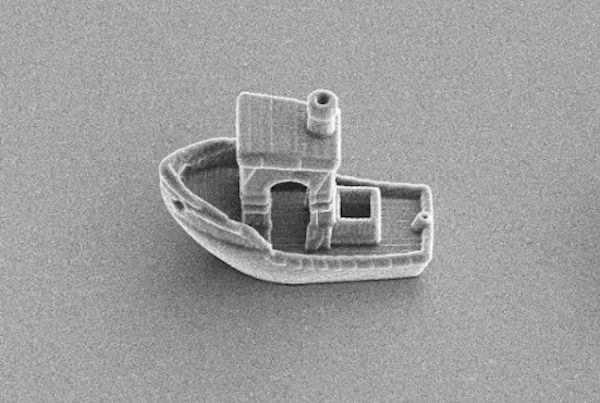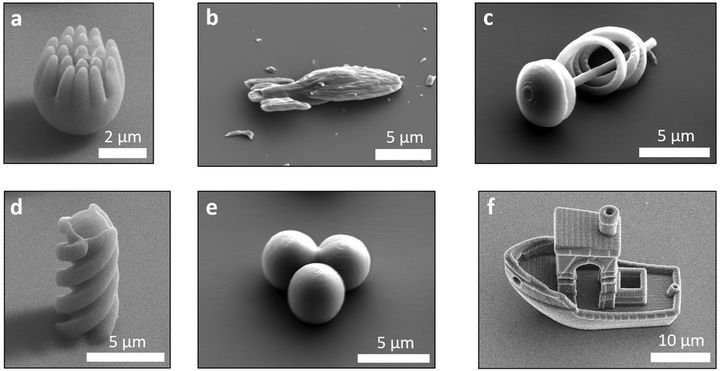
Researchers at the University of Leiden have been 3D printing microswimmers and are testing all options.
If you’re not familiar with the term “microswimmers”, like I was, the definition is actually quite straightforward: it’s a geometric shape that can move by itself in fluid. The Wiktionary definition is:
“A very small device that propels itself without friction by surface treadmilling.”
There are multiple applications for microswimmers, mostly in the healthcare segment. In particular, these tiny devices can be used to carry drugs to a targeted area of the body by “swimming” their way to the target.
What’s most fascinating about them is that they have no moving parts, and are usually powered externally through the application of acoustic vibrations, electromagnetic fields or even chemical action. Thus they are ideal for use in a living organism with an arterial system.
As you might suspect, it’s a bit tricky to manufacture these objects, as they are so incredibly small. As such it turns out that most of the microswimmers developed so far are essentially spheres, but there could be far more effective microswimmers if more complex designs were possible to manufacture.
Two-Photon Lithography
The researchers in this project decided to use two-photon lithography, a form of microscopic 3D printing, in an attempt to produce these tiny objects in much more complex forms.
Two-photon lithography uses a process in which a volume of resin is briefly illuminated from multiple directions in a way that allows a focal point in 3D space to receive more photons than the surrounding area, hence the term “two-photon”. When the energy received at a point is sufficient, the resin solidifies. By moving this focal point around in the 3D space of the resin, an object can be formed.
The catch here is that the size of the focal point is incredibly small because it’s effectively delivered with a scanning electron microscope operating in reverse. This allows the two-photon process to successfully 3D print very tiny objects.
Thus the researchers had their platform for producing a series of designs that would be tested for swimming effectiveness.
3D Printed Microswimmers

In their paper, “Catalytically propelled 3D printed colloidal microswimmers”, they explain the project:
“We establish the flexibility of 3D printing by two-photon polymerisation to produce particles smaller than 10 microns with a high-degree of shape complexity. We further demonstrate that 3D printing allows control over the location of the active site through orienting the particles in different directions during printing. We verify that particles behave colloidally by imaging their motion in the passive and active states and by investigating their mean square displacement. In addition, we find that particles exhibit shape-dependant behavior, thereby demonstrating the potential of our method to launch a wide-range of in-depth studies into shape-dependent active motion and behaviour.”
An interesting variation on their 3D printing process involved coating the prints:
“After drying, the structures were coated with a catalytically active 5 nm layer of Pt/Pd (80 : 20) using a Cressington 208HR sputter-coater. The sample was rotated during deposition to improve homogeneity of the resulting layer. After sputter-coating, excess Pt/Pd was removed from the substrate with a cotton bud without disturbing the printed structures.”
Coatings can offer a variety of functions, including protecting the living body from toxic resin materials or providing a means for propulsion through magnetism, for example.
The researchers produced a variety of experimental shapes to determine the viability of their use as microswimmers, and for some reason they included the famous #3DBenchy design in their set of geometries. While the Benchy is commonly used as a 3D benchmark in 3D printing at large scales, it’s amazing to see it also used in this experiment. It may be that this particular Benchy is the smallest one ever produced.
However, I have a strong suspicion its microswimming performance was somewhat poorer than the other experimental candidates.
In the end, the researchers seem to have succeeded:
“Our results demonstrate that 3D microprinting overcomes current limitations in the fabrication of active microswimmers with complex shapes and controlled patch location. It opens the door to studying and quantifying shape-dependent motion of active microswimmers, their interactions and collective behavior, but also navigation in complex environments that rely on alignment through shape-induced torques.”
This could be a very significant development, as the use of microswimmers could offer dramatic ways to improve medical therapies.
Via University of Leiden and RCS
